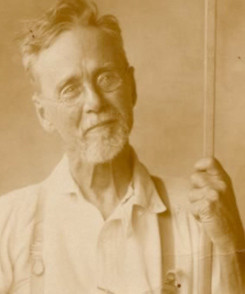About Osteopathy
Definition
History of Osteopathy
 Osteopathy was founded in the United States in the tail end of the XIXth century by Andrew Taylor Still (1828-1917). His father, a medical doctor and Methodist preacher, mentored him in medicine, which Andrew would thus practice throughout his time as a soldier in the American Civil War. In this era, he would explore his interest in the anatomy through dissections of cadavers, allowing him to gain an advanced knowledge of anatomy.
Osteopathy was founded in the United States in the tail end of the XIXth century by Andrew Taylor Still (1828-1917). His father, a medical doctor and Methodist preacher, mentored him in medicine, which Andrew would thus practice throughout his time as a soldier in the American Civil War. In this era, he would explore his interest in the anatomy through dissections of cadavers, allowing him to gain an advanced knowledge of anatomy.
In 1864, a portion of his family was decimated by a meningitis epidemic. The inability to save his own family with the aid of medicine catalysed deep skepticism of allopathic medicine. In 1874, Still moved to Kirksville, Missouri, to begin exploring and establishing the fundamental approach, concepts, and philosophies of osteopathy: “ ——”
By 1892, graced by his initial therapeutic successes, he founded the first osteopathic college, the American School of Osteopathy in Kirksville, Missouri. In this establishment, he would dispense the first diploma of a doctorate in osteopathic medicine in 1897. To this day, Kirksville remains known as the “cradle of osteopathy”.
At the beginning of the XXth century, the practice of osteopathy was authorized everywhere in the states and would begin to make its way around the world.
Treatment Methods
The osteopathic procedure’s goal is to favour local, regional and global homeostasis by use of precise manual normalisation and adjustment techniques. These manual techniques are done with respect to the soft tissue, visceral and articular physiology of the patient
Structural Technique
Structural osteopathy is applied to the musculoskeletal system using manipulative techniques. H. H. Fryette, who is considered the scientific father of these manipulations, that established the principle physiological laws of movement which served as the building blocs to structural techniques: the corrective movement applied must respect that of the articulation in normal conditions, one must never force an articulation.
Soft Tissue
The concept of the soft tissue osteopathic approach is to perceive and improve the mobility of all living tissue in the human body. With this approach comes an underlying concept that all trauma can leave an imprint or trace on the connective tissue (fascia), limiting their natural freedom of movement. The soft tissue mobilisation techniques aim to free the fascia of any hindrance and accumulated tensions.
Visceral
Visceral osteopathy is the study of the physiological movements of the viscera so that one can appreciate and differentiate eventual perturbations. The entirety of the organs and viscera for a sort of suspended system, sheathed in an envelope known as the peritoneum, which its mobility depends (by a mechanical point of view) on the abdominal cavity walls, notably the thoracic diaphragm. This visceral mobility can be affected by adherence, visceral-spasms, ptosis and cause functional pathology. The manual techniques aim to remove such restrictions of mobility from the abdominal-pelvic cavity and prevent painful symptoms that are often not identified by conventional complementary examinations.
Cranial Osteopathy
Developed by William G. Sutherland in the 1920s, cranial osteopathy is a treatment method that is inherently part of and works in conjunction with the general osteopathic approach. It is a fundamental approach that is part of an osteopath’s education and practice. Sutherland, a student of A. T. Still, proposed that the bones of the skull are functionally articulated and their movements respect precise axis. With precise palpation, the osteopath can locate zones of the cranial articulations with restricted mobility and act to release suture restrictions, intracranial and dura mater membranes and act on cerebrospinal fluid pressure, allowing a restoration of normal suture mobility. Because the continuity between the cranium and the sacrum is a fundamental concept of cranial osteopathy, the pelvis will also be investigated.
Cranial osteopathy treatments seek to alleviate and eliminate symptoms of headaches, burdens of the ENT region, congenital cranial deformations and torticollis of newborns, issues with sleep quality and some behavioural issues.
Fluid Osteopathy
The mean amount of water present in the adult human body is 65Q%, reaching as far as 78% in babies. This approach in osteopathy focuses on the continuity between the different circulating liquids in the human body. Furthermore, the rhythmic motion perceived in the cerebral spinal fluid of the central nervous system is diffused in the entire body, independent of the arterial circulation. In fluid osteopathy, the concept of the body as a whole is preponderant. But the principal characteristic of this approach is that the osteopath does not use any technique to treat the patient: the osteopath is but a point of support for the fluid movements in the body of the patient. These fluid movements aid in normalising different structures of the body to their physiological position. However, the effectiveness of the approach depends solely on the patient remaining in a calm and neutral state.
